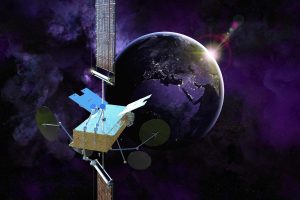A test flight, flown from Cranfield Airport using the National Flying Laboratory Centre’s Saab 340B aircraft, demonstrated the system in an aviation context.
Following Brexit, the UK is no longer part of the EU’s similar European Geostationary Navigation Overlay Service (EGNOS). This will supplement Galileo in a future version, and improves GPS by reporting on the reliability and accuracy of positioning data and sending out corrections.
This latest trial aims to provide a first step toward a UK SBAS that can be used for critical “safety of life” navigation services across air, land, and sea. (UK applications can still use EGNOS but its Safety-of-Life (SoL) service was officially withdrawn in June 2021.)
Viasat explained that UK SBAS can offer positioning down to a few centimeters of accuracy, rather than the few metres provided by standard GPS. For aviation, the system gives pilots greater trust in their onboard instruments, for example, such as when pilots may not be able to physically see a runway or other obstacles due to bad weather.
“This means improved safety and fewer missed landings because pilots – especially smaller aircraft flying into regional airports and general aviation airfields – can get significantly closer to the ground during an approach before making the decision whether to land. Viasat’s research with one regional flight operator indicated that close to 40% of flights cancelled due to weather could have gone ahead had UK SBAS been available for its fleet. Around the UK, 19 airports had EGNOS procedures in place prior to leaving the European Union. In total, as many as 72 airports no longer have access.”
With the aviation test complete, the trial will test the system in other transport applications, for example for rail, uncrewed aerial vehicles, or autonomous road vehicles.
Augmentation system
The way it works is that UK SBAS generates an overlay test signal to the US Global Positioning System (GPS) that is fully compliant with International Civil Aviation Organization (ICAO) standards.
The signal is broadcast in coordination with the US Federal Aviation Administration (FAA), the European Space Agency (ESA) and the European Union Space Programme Agency (EUSPA).
Broadcast capability for UK SBAS is being provided by Viasat’s I-3 F5 satellite.
Trial
“This trial on a sovereign UK SBAS is all about delivering trust,” said Todd McDonnell, President, International Government, Viasat.
“Trust for pilots in their tracking systems so they can stay safe in challenging conditions. Trust for the aviation industry more broadly so it can rely on data to operate more efficiently. And, in the future, trust that we can use highly accurate tracking to develop Britain’s transport system as new technologies come into play. We’re excited to continue the trial and see how far we can take it.”
Funding for the trial is coming from the Department for Transport via the European Space Agency’s NAVISP programme.
It is being completed by a Viasat-led team of companies in the UK, including Goonhilly Earth Station, CGI UK, GMV, Ordnance Survey, Cranfield University, the Cranfield National Flying Laboratory Centre, and Pildo Labs.
“This testbed project is vital in helping Government understand the potential benefits of a UK SBAS,” said Dean Thomas, Position, Navigation and Timing Lead at the UK Space Agency.
“The flight trial both demonstrates the capability of UK industry in delivering space based PNT solutions and illustrates the benefits of delivering UK PNT projects facilitated by ESA, through the highly flexible NAVISP programme.”
GPS+
Viasat highlights that a similar system, known as SouthPAN, is currently being developed for positioning, navigation and timing services (PNT) to be available in Australia and New Zealand.
Signals for the service would be provided by Viasat through one of its next-generation I-8 satellites, which are aimed to launch in 2027.
And as well as the United States’ Global Positioning System (GPS), the EU has its Galileo system, there’s Russia’s GLONASS, China’s BeiDou system, and Japan has its Quasi-Zenith Satellite System (QZSS)…
Image: Viasat – Representatives from organisations involved in UK Sovereign Satellite Based Augmentation System
See also: Viasat, Skylo to launch global direct-to-device network for IoT, logistics
 Electronics Weekly Electronics Design & Components Tech News
Electronics Weekly Electronics Design & Components Tech News




